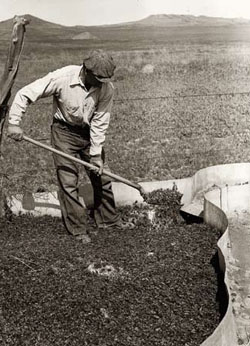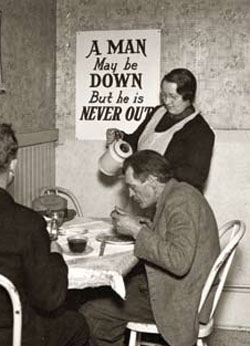Montana: Stories of the Land
Companion Website and Online Teacher's Guide
Chapter 18 - The Great Depression Transforms Montana, 1929-1941
Chapter 1 - Montana: Where the Land Writes History
Chapter 2 - People of the Dog Days
Chapter 3 - From Dog Days to Horse Warriors
Chapter 4 - Newcomers Explore the Region
Chapter 5 - Beaver, Bison, and Black Robes
Chapter 6 - Montana's Gold and Silver Boom
Chapter 7 - Two Worlds Collide
Chapter 8 - Livestock and the Open Range
Chapter 9 - Railroads Link Montana to the Nation
Chapter 10 - Politics and the Copper Kings
Chapter 11 - The Early Reservation Years
Chapter 12 - Logging in the "High Lonesome"
Chapter 13 - Homesteading This Dry Land
Chapter 14 - Towns Have Lives, Too
Chapter 15 - Progressive Montana
Chapter 16 - Montana and World War I
Chapter 17 - Montanans on the Move
Chapter 18 - The Great Depression Transforms Montana
Chapter 19 - World War II in Montana
Chapter 20 - Building a New Montana
Chapter 21 - A People's Constitution
Chapter 22 - Living in a New Montana
Educator Resources
Takeaways
-
Inspired by reading specialist Tammy Elser, who was in turn inspired by SKC graduate Taylor Crawford, we've created a "Takeaway" bookmark for every chapter of Montana: Stories of the Land. Before starting a chapter, print and cut out these bookmarks and distribute them to your students. Ask them to use the Takeaway to summarize the GIST of what they learn from reading assigned sections of the chapter. Remind them that they don't have much room, so they'll need to think before they write down the most important idea they want to take away from the section. Learn a little more about the GIST strategy.
-
Even though we've created Takeaways for every chapter, we don't recommend you have your students complete a Takeaway for every section of every chapter they read. That would be exceedingly tedious. However, used appropriately, they can be a useful tool for encouraging reflection and teaching students how to summarize information.
Websites and Online Lesson Plans
-
Part 1 of Hope in Hard Times: New Deal Photographs of Montana, 1936-1942, by Mary Murphy, is the best thing written on the Great Depression in Montana (and the pictures are great too.) You can download it here.
-
Professor Murphy was also guest curator for a Montana Historical Society exhibit of the same name. That exhibit is now available as a Powerpoint presentation to download for use in the classroom. (Look in the Notes section for additional information to share with your students).
-
The Annotated Resource Set The Great Depression Transforms Montana, 1929-1941, includes links to photographs, maps, illustrations, and documents relating to the Great Depression in Montana. Many, but not all, of the images were also used to illustrate Chapter 18 of Montana: Stories of the Land. These sources can be used to build PowerPoints or to create DBQs or other primary-source based activities.
-
Find out some of the ways the New Deal affected your community by searching the Montana Historical Society Research Center's index to WPA microfilm. An index of correspondence, the list can be used to determine the types and locations of WPA projects in Montana. A key-word search using the name of your town or county can provide students a sense of the range of projects that were funded in your area.
-
A full-text, searchable version of the Federal Writer's Project Guide to Montana is now available. The guide - created by unemployed writers under the auspices of the Federal Writers Project - is another legacy of the WPA.
-
FortPeckDam.Com is a site dedicated to the history of the construction of the Fort Peck Dam, with over 500 historical photos.
-
Montana State University (MSU) Archives has digitized material from the Federal Work Projects Administration (WPA) Papers and Photos, a massive collection of Montana WPA records.
-
The National Archives' Teaching with Documents project has a lesson centered around "FDR's First Inaugural Address: Declaring 'War' on the Great Depression."
-
Helena High School teacher Jean O’Connor has created a lesson plan linking the study of the Depression in Montana to literature studies (either of Grapes of Wrath or Out of the Dust). Her lesson plan also offers a suggestion for creative writing based on these letters from drought-stricken farmers. See her lesson plan, “Experiencing the Depression in Montana.
Videos or DVDs
-
Chapter Three, "The Great Depression," (18 minutes) of Montana Mosaic: 20th Century People and Events. (Site includes links to both User Guides with discussion questions and videos.)
-
Fort Peck Dam – 56 minutes
-
1934 Indian Reorganization Act and Its Effect on Leadership, Vernon Finley – 7:30 minutes
Possible Field Trips: View the Map
-
Fort Peck Interpretive Center & Museum, Fort Peck
Chapter 18 Test and Answer Keys Page
The tests and answer keys are password protected.
You can contact us to receive the password:
- Martha Kohl - call (406) 444-4790 or email mkohl@mt.gov
- Melissa Hibbard - call (406) 444-4741 or email Melissa.Hibbard@mt.gov
Or, if you used the old system, the original username is now the new password. You will be asked for this case-sensitive password every time you open a new document.
Alignment to ELA Common Core Standards
Alignment to Content Standards and Essential Understandings Regarding Montana Indians (EU)


